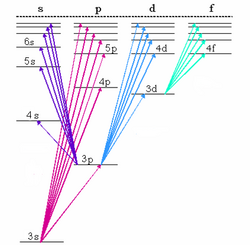Physics:Principal series (spectroscopy)
In atomic emission spectroscopy, the principal series is a series of spectral lines caused when electrons move between p orbitals of an atom and the lowest available s orbital. These lines are usually found in the visible and ultraviolet portions of the electromagnetic spectrum. The principal series has given the letter p to the p atomic orbital and subshell.[1]

The lines are absorption lines when the electron gains energy from an s subshell to a p subshell. When electrons descend in energy they produce an emission spectrum. The term principal came about because this series of lines is observed both in absorption and emission for alkali metal vapours.[2] Other series of lines appear in the emission spectrum only and not in the absorption spectrum, and were named the sharp series and the diffuse series based on the appearance of the lines.[3][2]
References
- ↑ Laidler, Keith J.; Meiser, John H. (1982). Physical Chemistry. Benjamin/Cummings. p. 488. ISBN 0-8053-5682-7. "The letters s, p, d and f relate to the descriptions "sharp", "principal", ... that the early spectroscopists had given to series of lines in atomic spectra."
- ↑ 2.0 2.1 Bernath, Peter F. (2020). Spectra of Atoms and Molecules. Oxford University Press [page=116. ISBN 978-0-19-009540-6. https://books.google.com/books?id=4wbcDwAAQBAJ&dq=%22principal+series%22+%22both+absorption+and+emission%22&pg=PA116. Retrieved 5 September 2021. "The names sharp and diffuse were based on the appearance of the lines, while the principal series appeared in both absorption and emission."
- ↑ "Spectroscopic Notation". Caltech Department of Astronomy. https://sites.astro.caltech.edu/~srk/Ay102/Files/spdfHistory.pdf. "In the emission spectra of the alkali elements other series appeared in addition to the principal series of the absorption spectrum."
 |

